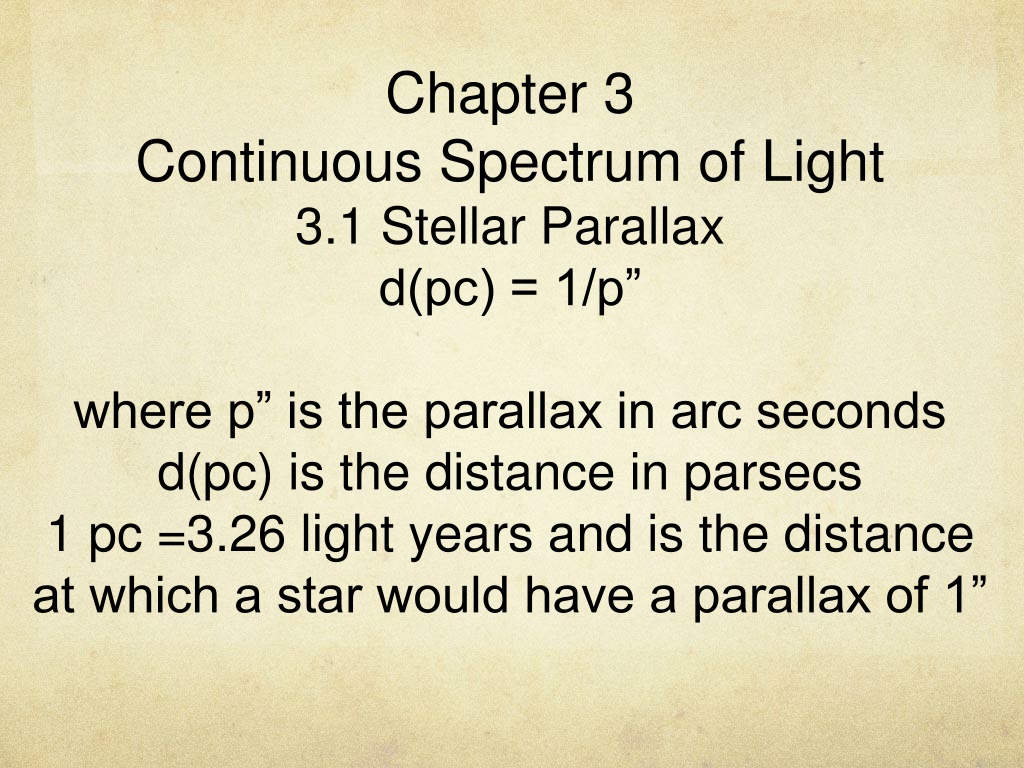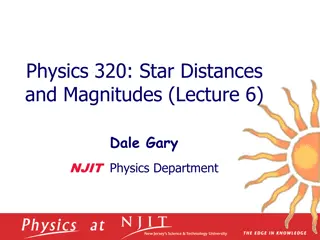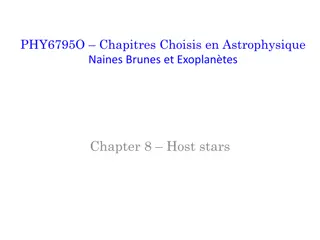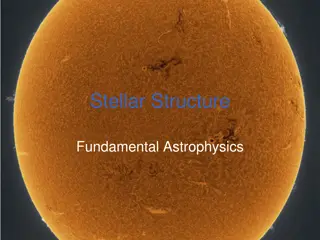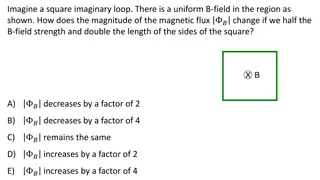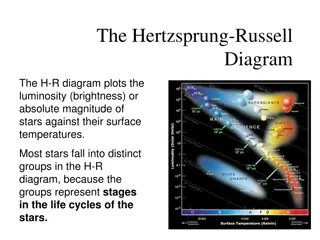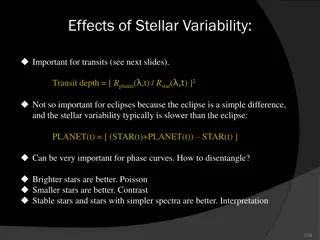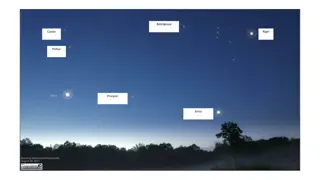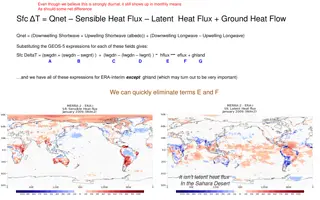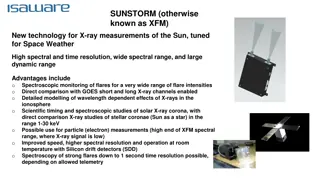Understanding Stellar Properties: Distance, Brightness, and Flux
Explore the fascinating realm of stellar astronomy with topics such as stellar parallax, magnitude scales, luminosity, radiant flux, and the inverse square law. Learn about measuring distances to stars, comparing their brightness, and understanding the energy they emit into space. Dive into the intricacies of star properties and the fundamental laws governing their visibility and luminosity.
Uploaded on Sep 17, 2024 | 0 Views
Download Presentation

Please find below an Image/Link to download the presentation.
The content on the website is provided AS IS for your information and personal use only. It may not be sold, licensed, or shared on other websites without obtaining consent from the author. Download presentation by click this link. If you encounter any issues during the download, it is possible that the publisher has removed the file from their server.
E N D
Presentation Transcript
Chapter 3 Continuous Spectrum of Light 3.1 Stellar Parallax d(pc) = 1/p where p is the parallax in arc seconds d(pc) is the distance in parsecs 1 pc =3.26 light years and is the distance at which a star would have a parallax of 1
Chapter 3.2 The Magnitude Scale Apparent Magnitude Invented by Hipparchus. The brightest stars were 1stmagnitude and the faintest, 6th magnitude. The lower the number, the brighter the star. Norman Pogson discovered that a difference of 5 magnitudes corresponds to a factor of 100 in brightness. A difference of 1 magnitude corresponds to a brightness ratio of 1001/5 ~ 2.512.
The Magnitude Scale Apparent Magnitude A first magnitude star is 2.512 times brighter than a 2ndmagnitude star, etc. Apparent magnitude, m, for the sun -26.83. Faintest object detectable, m = 30. Faintest star a person with 20/20 vision can see is ~6thmagnitude.
The Magnitude Scale Absolute Magnitude This is the apparent magnitude a star would have if it were 10 parsecs or 32.6 light years distant.
Radiant Flux A star s brightness is the total amount of starlight energy/second at all wavelengths (bolometric) incident on one square meter of detector pointed at the star. This is called the radiant flux, F and is measured in watts/m2.
Luminosity Luminosity, L is the total amount of energy emitted by a star into space.
Inverse Square Law The relationship between a star s luminosity L, and its radiant flux, F is: L F = 4pr2 where r is the distance to the star.
Inverse Square Law Knowing the values for the sun s luminosity, L and using 1 AU for the average Earth-sun distance, for r, the solar flux, F received by the Earth from the sun is: F = 1365 W/m2, This is also known as the solar constant.
Distance Modulus A measure of the distance to a star is called its distance modulus, or m M. m M = 5log10(d) 5 = 5 log10 (d/10 pc) Remember, that M is the magnitude a star would have if it were 10 pc (parsecs) distant.
Distance Modulus The distance modulus is a logarithmic measure of the distance to a star. Here s a listing of m, M, and m M of notable stars: Star Name m M m M Sirius -1.5 1.4 -2.9 Alpha Centauri A 0.0 4.4 -4.4 Alpha Centauri B 1.4 5.8 -4.4 Proxima Centauri 10.7 15.1 -4.4 Sun -26.75 4.83 -31.58
Distance Modulus Example to calculate the M of Proxima Centauri: m M = 5 log10 (d/10 pc) M = m - 5 log10 (d/10 pc) For Proxima Centauri, d = 1.295 pc, m = 10.7 (it s a red dwarf). M = 10.7 - 5log10 (1.295/10) = 15.1
Chapter 3.4 Blackbody Radiation A blackbody is defined as an object that does not reflect or scatter radiation shining upon it, but absorbs and reemits the radiation completely. It is a kind of ideal radiator, which cannot really exist. However, stars and planets behave as if they were blackbodies. Blackbody radiation depends only on its temperature and is independent of its shape, material and construction.
Blackbody Radiation This figure shows the blackbody spectrum of an object has a certain peak, and goes to shorter wavelengths as the temperature increases.
The Planck Function Bl(T)=2hc2/l5 ehc/lkT-1 where h = Planck s constant = 6.626 x 10-34J s and the units of B (T) are W m-3 sr-1
Wiens Law Notice that the peak of a BB curve goes to shorter and shorter wavelengths as T increases. This is Wien s Law. maxT = 0.0029 m K
Chapter 3.4 Blackbody Radiation Remember this animation site? http://www.astro.ubc.ca/~scharein/a311/Sim.html It has a great blackbody simulation/animation!
Wiens Law Example: 3.4.1 What is max for Betelgeuse? Its temperature is 3600 K. lmax@0.0029mK 8.05x10-7m=805nm 3600K which is in the IR.
Wiens Law Example: 3.4.1 Similarly for Rigel. What is max for Rigel? Its temperature is 13,000 K. lmax@0.0029mK 13,000K 2.23x10-7m=223nm which is in the UV.
Chapter 3.6 Color Index The Johnson - Morgan UBV Filter System
Chapter 3.6 Color Index The Johnson - Morgan UBV Filter System Approximate central wavelengths and bandwidths are: < > ( A) ( A) Band U 3600 560 B 4400 990 V 5500 880
Color Index Color index is related to a star s temperature. Figure below is from http://csep10.phys.utk.edu/astr162/lect/stars/cindex.html
Returning to The Planck Function Bl(T)=2hc2/l5 ehc/lkT-1 where h = Planck s constant = 6.626 x 10-34J s and the units of B (T) are W m-3 sr-1
Exploring the Planck Function Let s investigate this function. Bl(T)=2hc2/l5 ehc/lkT-1 The exponent in the denominator is sometimes written as . And = hc/ kT, has no units, ie. it is dimensionless. h = 6.626068 x 10-34 joule sec k =1.38066 x 10-23 joule deg-1 c =2.997925 x 108 m/s T = object temperature in Kelvins
Example Using the Planck Function Let s do an example with this function. Consider an object at 213 K and let s compute the emitted radiance at 10 microns. Everything is in SI units, i.e. meters and joules. We have that =, (6.63x10-34Js)(3.0x108m/s (1.38x10-23J /K)(1x10-5m)(213K)=6.77 b = Notice that all of the units cancel. The denominator of the Planck function is e6.77-1 = 870.3
Example Using the Planck Function The numerator becomes 2(6.63 10 34 Js)(3.0 108m/s)2(1.0 10 5m) 5 =119.3 107Jm 3s 1steradian 1 The full Planck function becomes B =119.3 107/870.3 = 0.137 107Jm 3s 1steradian 1 and the units of B (T) are W m-3 sr-1
Back to Color Indices and the Bolometric Correction A star s U B color index is the difference between its UV and blue magnitudes. A star s B V color index is the difference between its blue and visual magnitudes. The difference between a star s bolometric magnitude and its visual magnitude is its bolometric correction BC. A bolometric magnitude includes extra flux emitted at other wavelengths. The magnitude adjustment that takes into account this extra flux is the bolometric correction. mbol V = Mbol MV = BC
Color Indices and the Bolometric Correction One can associate an absolute magnitude with each of the filters. U B = MU MB B V = MB MV The difference between a star s bolometric magnitude and its visual magnitude is: mbol V = Mbol MV = BC
Bolometric Correction The significance of the bolometric correction is that, the greater its value, either positive or negative, the more radiation the star is emitting at wavelengths other than those in the visible part of the spectrum. This is the case with very hot stars, where most of their radiation is in the UV. The BC would be negative. This is also the case with very cool stars, where most of their radiation is in the IR. The BC would be posative. The BC is least with sun-like stars, since most of their radiation is in the visible part of the spectrum. The BC would ~ 0.
Example Using Bolometric Correction For Sirius, U = -1.47, B = -1.43, V = -1.44 U B = -1.47 (-1.43) = -0.04 B V = -1.43 (-1.44) = 0.01 This shows that Sirius is brightest at UV wavelengths, which is what you would expect, since T = 9970 K. lmax=0.0029mK 9970K =291nm which is in the UV part of the electromagnetic spectrum. The bolometric correction for Sirius is BC = -0.09. Apparent bolometric magnitude is: mbol = V + BC = -1.44 + (-0.09) = -1.53 BC is negative for a hot star like Sirius. BC is positive for a cool star like Betelgeuse.
